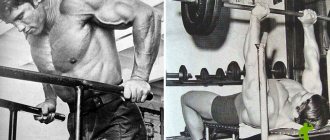A competent program for working out muscles is the basis of training progress.
It is this that will ensure intensive muscle growth and a balanced load.
In this article we will analyze the features of various programs, effective exercises and the specifics of training.
Let's draw up a rough training plan for men and women for different muscle groups.
Rules for creating your own weekly program
The ability to create an individual program for sports activities is a key characteristic of an advanced athlete and the dream of any beginner.
Preparation of such a program includes the following steps:
- write a basic training plan. First there should be a warm-up (about 10 minutes), 2 exercises for any of the main muscle groups (legs, back, chest), 3 exercises for secondary muscles (shoulders, biceps, triceps), and a cool-down (5 minutes). If you are focused on losing excess weight, you need to devote 20 minutes to cardio after strength training;
- set the main goal and objectives. The weakest muscle groups (especially if they are secondary) can be trained 2 times a week with a break of a couple of days for proper rest and recovery (for example, on Monday and Thursday);
Note! To work out your abs, you can include 3 sets of planks right into your warm-up, and leg raises or another similar exercise for several muscle groups during your cool-down.
- choose suitable exercise options. To the first set of exercises (load on large muscle groups), it is recommended to add basic loads or their variations on special exercise machines. You need to add isolated loads to the combination of small muscle exercises, changing them regularly to check the effectiveness. The selection of exercises largely depends on what exercise equipment and auxiliary devices you have in your home and gym;
- determine the number of approaches and repetitions. The total number of sets for each large muscle group should be 12-15 (i.e. 3 exercises of 4 sets or 4 exercises of 3-4 sets). The first set should use a fairly heavy weight and a minimum number of repetitions (from 8 to 12), while the second set should use a working weight and an increased number of repetitions (12 to 15).
Be sure to check out: Split program: training to pump up muscles with proven effectiveness Monthly training program: rules for drawing up a plan and sets of exercises Detailed training program with your own weight at home Effective training program for gaining muscle mass 3 times a week
Frequency and duration of classes
To create the right training regimen for a certain period of time, you need to decide on their frequency and duration. Adhere to the following rules:
- Every week, train all significant muscles, trying to evenly distribute the load. The sports training regime is characterized by regularity;
- Allow each muscle group to rest for at least 72 hours after exercise;
- Try to study on the same days of the week and at approximately the same time;
- Remember that the more your muscles are trained, the more time they will need to recover.
It should be noted that most beginners and people who engage in bodybuilding solely for pleasure adhere to a sports training regimen. Each workout focuses on specific muscle groups. This is an ideal option for an athlete who wants to gain mass. The right training regimen should be comfortable for you.
Experienced bodybuilders can train 5 or 6 times a week. People who work to lose weight or create a beautiful figure also often train. Try to create a workout routine that is ideal for achieving your goals and that is easy to stick to.
As for the duration of classes, it must be said that the most effective training programs in bodybuilding do not exceed 1 hour. It is recommended to exercise longer only during the drying period or while fighting excess weight. Muscles do not grow directly during training, but during the rest period after it. Everyone has their own training regimen system, you just need to find the one that suits you.
Sample lesson plan for women
Exercises for weight loss
Strength training with weights (most often called “base” by professionals) burns a huge amount of calories. This result is quite natural: such exercises require enormous energy expenditure. However, it will not be possible to constantly do basic exercises if your body is experiencing a calorie deficit (calorie restrictions are inevitable in the process of losing weight). In this case, they can exhaust the body and contribute to the appearance of overtraining. Strength loads during weight loss should be used in doses.
And long-term loads at an average rhythm (for example, running, aerobic exercises or high-repetition exercises with light weights) do not load the losing weight body as intensely as strength training, so their quantity should prevail. The number of workouts per week is 4-5.
Note ! There is a special concept - “heart rate zone for fat burning” (approximately 70% of peak heart rate). It is believed that with such a pulse, the body burns subcutaneous fat as intensively as possible.
Example program:
- Warm-up: cardio exercise (30 minutes).
- Smith Squats: 3 sets of 12 reps (light weight).
- Lunges with weights: 3-4 sets of 15 times for each leg separately.
- Hyperextension on a bench: 3 sets of 15 repetitions.
- Curls with dumbbells (“hammers”): 4 sets of 15 reps.
- Crunches: 4 sets of 15 times.
- Roman chair sit-ups: 3-4 sets of 15 reps.
- Cool down: cardio (at least 25 minutes).
Exercises for relief
Relief training involves 5-6 workouts per week, but all of them should be strength training. The optimal option is 3 strength exercises and 2 cardio (running at a moderate pace, jumping rope, swimming). This version of the relief program will allow you to achieve the best results.
The number of repetitions should vary from 12 to 15 times in 1 set. The weight used is average (depending on the individual level of physical fitness). The weight is selected in such a way that the athlete can do 12 repetitions while maintaining the correct technique.
There are no clear recommendations regarding the number of approaches in relief training - you should focus on your body and the planned list of exercises. For example, if you decide to perform 8 exercises in one session, stop at the minimum number of sets (3). With less variety of loads, gradually increase the total number of approaches.
Example program:
- Warm-up: cardio (15 minutes).
- Raises with weights: 4 sets of 15 reps.
- Lifting dumbbells to the shoulders: 3-4 sets of 12-15 times.
- Lat Pulldown: 4 sets of 12 reps.
- Push-ups: 3 sets of 12 reps.
- Crunches (incline bench): 4 sets of 12 reps.
- Cool down: cardio (at least 10 minutes).
Massive exercises
Gaining muscle mass is simply impossible without the use of basic multi-joint exercises. It is important to note that such training excludes a large number of repetitions, light weights and long-term cardio training - all this simply will not allow the muscles to increase in volume.
In mass training, you should use a minimum number of repetitions (8-10) and sets (3) with a large working weight (determined individually). The number of workouts per week is 2-3.
Example program:
- Warm-up: cardio exercise (10 minutes).
- Deadlift: 3 sets of 8-10 reps.
- Squats with weights: 3 sets of 10 reps.
- Leg press: 3 sets of 8 repetitions.
- Weighted lunges: 3 sets of 8-10 reps for each leg.
- Lying leg curls: 3 sets of 10 reps.
Work intensity
When creating an individual system for training, or choosing a ready-made option, you need to think about the intensity of the load. The parameter under consideration is no less important than the frequency and duration of classes. It depends directly on the purpose for which you came to the gym.
To build muscle, lift heavy weights at low intensity. It is recommended to do each exercise in 3 sets of 6 – 10 repetitions. You are allowed to rest between sets and the minimum rest time will be 1 minute.
Do you want to get rid of fat deposits and are working on your relief? This means you need to do 12–15 repetitions of one movement. The number of approaches will depend on the nature of the exercise you perform, and the rest time should not exceed 30 seconds.
Follow these rules when choosing the training program you will follow or creating your own version. This approach to bodybuilding training will help you achieve high results!
Effective sets of exercises for men
Exercises for weight loss
The training program for men who want to lose weight should be as intense and quite dense as possible. To get noticeable results, you need to exercise 4-5 times a week, and the duration of each workout should be at least 60 minutes + cardio (at least 30 minutes per day). 3-4 classes per week are recommended.
Such an intense schedule will help create an active calorie expenditure and speed up the process of breaking down fat in the body.
Example of a lesson program:
- Warm-up: cardio exercise (at least 30 minutes).
- Dumbbell bench press: 3 sets of 12 repetitions.
- Push-ups on the horizontal bar: 3 sets of 12-15 times.
- Dumbbell raises: 3-4 sets of 15 repetitions.
- Incline crunches: 4 sets of 15 reps.
- Cool down: cardio (10 minutes).
Exercises for relief
Relief exercises for men should consist of basic exercises (aimed at maintaining muscle volume) and a sufficient number of isolated exercises (allowing to improve muscle relief).
Each strength training should focus on working 1-2 muscle groups. The training plan drawn up should not take much time; the optimal duration of the lesson is 1 hour. To work out the relief, the principle of pumping is often used - exercises are performed with high frequency and multiple repetitions. Training frequency – 4-5 times a week.
Sample program:
- Warm-up: cardio (15 minutes).
- Leg curls in the simulator: 4 sets of 15 repetitions.
- Leg extensions in a special machine: 4 sets of 15 repetitions.
- Barbell squats: 3-4 sets of 12-15 reps.
- Side lunges: 4 sets of 12 reps.
- Cool down: cardio (at least 10 minutes).
Mass training
For the growth of muscle mass, constant progression of weight (weights in exercises) and a small number of repetitions (about 8 times) are most important. For optimal recovery of the entire body, the break between workouts should last at least 2 days (2 sessions per week).
Important ! Do not chase the number of repetitions with heavy weights - more than 12 repetitions per set will train endurance, and not contribute to weight gain.
Example program:
- Warm-up: cardio exercise (10 minutes).
- Bench press: 3 sets of 8 reps.
- Raises with weights: 3 sets of 10 repetitions.
- Barbell lifts: 3 sets of 8-10 reps.
- Arm curls (“hammers”): 3 sets of 8 times.
Strength exercises
Maximum strength indicators are developed by performing basic exercises with heavy weights. The number of approaches should be 3-5 for one exercise.
Note! There is no need to do a set with the maximum possible weight right away - this will create a lot of stress for the body. Increase the weight gradually, and use the first set of any exercise to warm up the target muscles.
For an intense workout, use a combination of compound weight exercises along with isolation exercises on cable machines.
Be prepared for long workouts (about 2 hours or more). This specificity of the exercises is due to the fact that after each approach a long rest is required - about 5 minutes. In this case, the effectiveness of training will be noticeable only with sufficient muscle rest. Also, do not forget about cardio loads before each strength training: 5-10 minutes of running at medium speed. The frequency of training is at least 2 times a week (rest after each – 36-48 hours).
Indicative lesson plan for strength:
- Warm up: cardio (at least 10 minutes).
- Barbell press (close grip): 4 sets of 8 reps.
- Military press: 3-4 sets of 8 reps.
- Barbell row (incline position): 4 sets of 8 reps.
- Dumbbell shrugs: 3 sets of 10 reps.
- Cool down: cardio (at least 10 minutes).
Classification of exercises
The next step is choosing exercises. By type of physical activity they are divided into:
- Anaerobic. These are strength exercises - the energy of muscle contractions comes from the use of creatine phosphate and glycogen, along the path of anaerobic glycolysis with the subsequent formation of lactic acid.
- Aerobic. These are cardio exercises. The body is provided with energy from glucose, glycogen and fatty acids, which, when oxidized, release adenosine triphosphate (ATP).
- Complex. A combination of strength and cardio exercises. The body is provided with energy, which is generated as a result of the consumption of fats, creatine phosphate and glycogen. In this case, two types of glycolysis are used: aerobic and anaerobic.
Interesting fact. Usually in gyms they choose anaerobic exercise, which involves the use of various weights. Such exercises do not promote fat burning, but help build muscle mass.
If you plan to lose weight, your training program should consist primarily of aerobic or cardio exercise. Only in this case can you achieve “melting out” of fat.
The following complex exercises, performed on a stepper, treadmill and exercise bike, are perfect for training. For improved results, it is worth combining them with stepping onto a bench, climbing stairs and jumping out of a low squat. By skillfully combining them, you can create a simple but effective workout.
To increase muscle mass, we give preference to standard strength training:
- Deadlift.
- Bench press lying on a horizontal bench or in French.
- Squats with a barbell on your shoulders.
- Biceps with straight bar.
- Upper block rows with a wide or narrow grip.
- Hand placement, etc.
If, in order to “dry out”, achieve beautiful relief and endurance, you should pay attention to CrossFit:
- High jump.
- Deadlift with light weight.
- Pull-ups on bars or bar.
- Dips.
- Barbell curls for biceps.
- Leg raises on the bar (they must be straight).
Creating a training program for muscle growth and strength development[edit | edit code]
Yuzhakov Anton How to create a training program in natural training.
Yuzhakov Anton How to create a training program
Yuzhakov Anton Load cycling in BB
Yuzhakov Anton Load periodization in BB
Drawing up a training plan taking into account time constraints
Planning training to increase strength.
This article tells you how to independently create a training program that will be ideal for you, describes in detail the basic principles of construction depending on your goals (gaining muscle mass [1], increasing strength indicators or working on relief), lists the rules that should be used when choosing an exercise and what to consider, outlines the basics of split training and discusses common mistakes.
However, it is worth understanding that the training aimed at muscle hypertrophy of a natural athlete not using steroids is very different from the training of a bodybuilder using pharmacological support. Therefore, this information must be adapted to your age, training experience, health status and goals. One of the mistakes a beginner [2] makes in natural bodybuilding is copying the training programs of professional athletes at the competitive level.
The structure of strength training, the order of exercises performed, the importance of warm-up and cool-down
This manual is based on the work of Christian Thibado, a long-time weightlifter and specialist in developing training programs. To achieve a good result, you must carefully study each and every step, which are given in sequential order:
- Choosing a training goal
- a training program should not pursue several goals at once. The same applies to diet and choice of sports nutrition. - Drawing up a split program
- the modern principle of training involves training different muscle groups on different days. This step needs to be given special attention. - Number of repetitions for mass and strength in the exercise
- Number of approaches per muscle group
- Number of exercises per muscle group
- Choosing exercises in bodybuilding
- The best exercises for gaining muscle mass
- Exercise speed
- The order of doing exercises in the gym
- Rest between exercises and sets
- Rest between workouts
- Optimal training duration
- Best time to train
- Advanced techniques in bodybuilding
- Electronic training diary
This list contains well-systematized, proven and only necessary knowledge on strength training. You can find additional information in the thematic section.
| Paragraph | Purpose of the training | ||||
| Force | Explosive force | Hypertrophy | Endurance | Speed | |
| Load (% of 1RM[3]) | 80-90 | 45-60 | 60-80 | 40-60 | 30 |
| Repetitions per set | 1-5 | 1-5 | 6-12 | 13-60 | 1-5 |
| Sets per exercise | 4-7 | 3-5 | 4-8 | 2-4 | 3-5 |
| Rest between sets (min.) | 2-6 | 2-6 | 2-5 | 1-2 | 2-5 |
| Duration (seconds per set) | 5-10 | 4-8 | 20-60 | 80-150 | 20-40 |
| repetition rate (% of max) | 60-100 | 90-100 | 60-90 | 60-80 | 100 |
| Workouts per week | 3-6 | 3-6 | 5-7 | 8-14 | 3-6 |
| Table from the book “Supertraining” by Mel C. Siff, 2003 | |||||
Author's word[edit | edit code]
This article reveals to the reader the strategy and tactics that allow you to independently create an individual training program. Bodybuilding and fitness trainers who write for magazines usually offer a wide variety of variations and sometimes bend some of the rules I outlined. However, you should understand that in order to circumvent the rules (without loss of quality and efficiency), you must carefully master the basic knowledge. If you want to create advanced programs for yourself or other people, then you need to start with practical work on composing classical programs. Then you will no doubt learn to develop advanced techniques as needed.
In other words, you first need to get a self-educated diploma, and only then think about a dissertation. Take your time, apply this knowledge wisely, step by step, and before you know it, you will begin to create reasonable, logical and effective training programs yourself.
Material evaluation[edit | edit code]
One famous trainer was asked to evaluate the work of Christian Thibadeau, “How to create a training program.” He said: “From now on I hate him because he revealed all the top secrets of professional trainers.”











